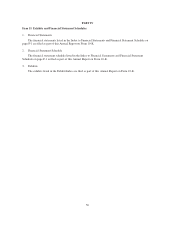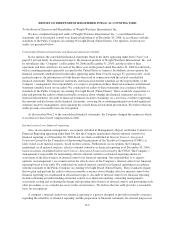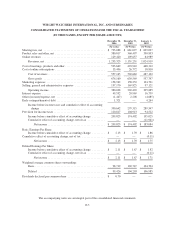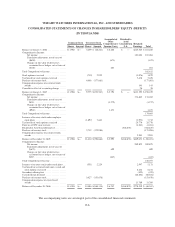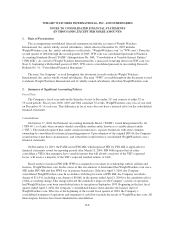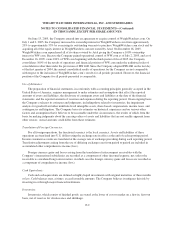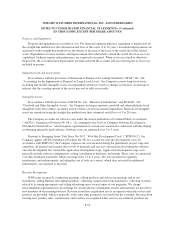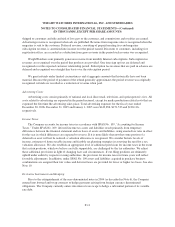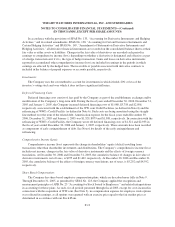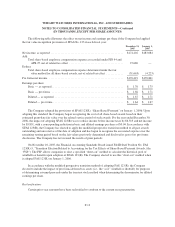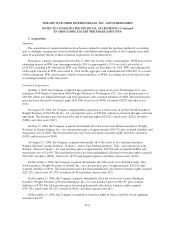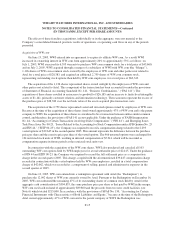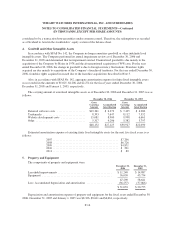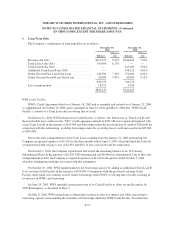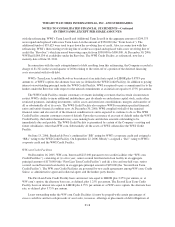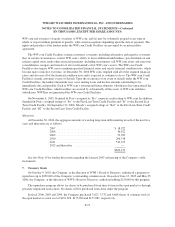WeightWatchers 2006 Annual Report Download - page 72
Download and view the complete annual report
Please find page 72 of the 2006 WeightWatchers annual report below. You can navigate through the pages in the report by either clicking on the pages listed below, or by using the keyword search tool below to find specific information within the annual report.WEIGHT WATCHERS INTERNATIONAL, INC. AND SUBSIDIARIES
NOTES TO CONSOLIDATED FINANCIAL STATEMENTS—(Continued)
(IN THOUSANDS, EXCEPT PER SHARE AMOUNTS)
On June 13, 2005, the Company entered into an agreement to acquire control of WeightWatchers.com. On
July 1 and 2, 2005, the Company increased its ownership interest in WeightWatchers.com from approximately
20% to approximately 53% by exercising its outstanding warrants to purchase WeightWatchers.com stock and by
acquiring all of the equity interest in WeightWatchers.com not owned by Artal. On December 16, 2005,
WeightWatchers.com repurchased all of its shares owned by Artal giving the Company a 100% ownership
interest in WW.com. Because the Company gained operational control of WW.com as of July 2, 2005, and as of
December 16, 2005, owns 100% of WW.com beginning with the third quarter of fiscal 2005, the Company
consolidates 100% of the results of operations and financial position of WW.com under the traditional rules of
consolidation rather than under the provisions of FIN 46R. Since the Company adopted FIN 46R on the last day
of the first quarter of 2004, the annual consolidated results of operations for the Company are not comparable
with respect to the inclusion of WeightWatchers.com’s results for all periods presented. However, the financial
position of the Company for all periods presented is comparable.
Use of Estimates:
The preparation of financial statements, in conformity with accounting principles generally accepted in the
United States of America, requires management to make estimates and assumptions that affect the reported
amounts of assets and liabilities, the disclosure of contingent assets and liabilities at the date of the financial
statements, and the reported amounts of revenues and expenses during the reporting period. On an ongoing basis,
the Company evaluates its estimates and judgments, including those related to inventories, the impairment
analysis for goodwill and other indefinite-lived intangible assets, share-based compensation, income taxes, and
contingencies and litigation. The Company bases its estimates on historical experience and on various other
factors and assumptions that it believes to be reasonable under the circumstances, the results of which form the
basis for making judgments about the carrying values of assets and liabilities that are not readily apparent from
other sources. Actual amounts could differ from these estimates.
Translation of Foreign Currencies:
For all foreign operations, the functional currency is the local currency. Assets and liabilities of these
operations are translated into U.S. dollars using the exchange rate in effect at the end of each reporting period.
Income statement accounts are translated at the average rate of exchange prevailing during each reporting period.
Translation adjustments arising from the use of differing exchange rates from period to period are included in
accumulated other comprehensive income (loss).
Foreign currency gains and losses arising from the translation of intercompany receivables with the
Company’s international subsidiaries are recorded as a component of other (income)/expense, net, unless the
receivable is considered long-term in nature, in which case the foreign currency gains and losses are recorded as
a component of comprehensive income (loss).
Cash Equivalents:
Cash and cash equivalents are defined as highly liquid investments with original maturities of three months
or less. Cash balances may, at times, exceed insurable amounts. The Company believes it mitigates this risk by
investing in or through major financial institutions.
Inventories:
Inventories, which consist of finished goods, are stated at the lower of cost or market on a first-in, first-out
basis, net of reserves for obsolescence and shrinkage.
F-9



